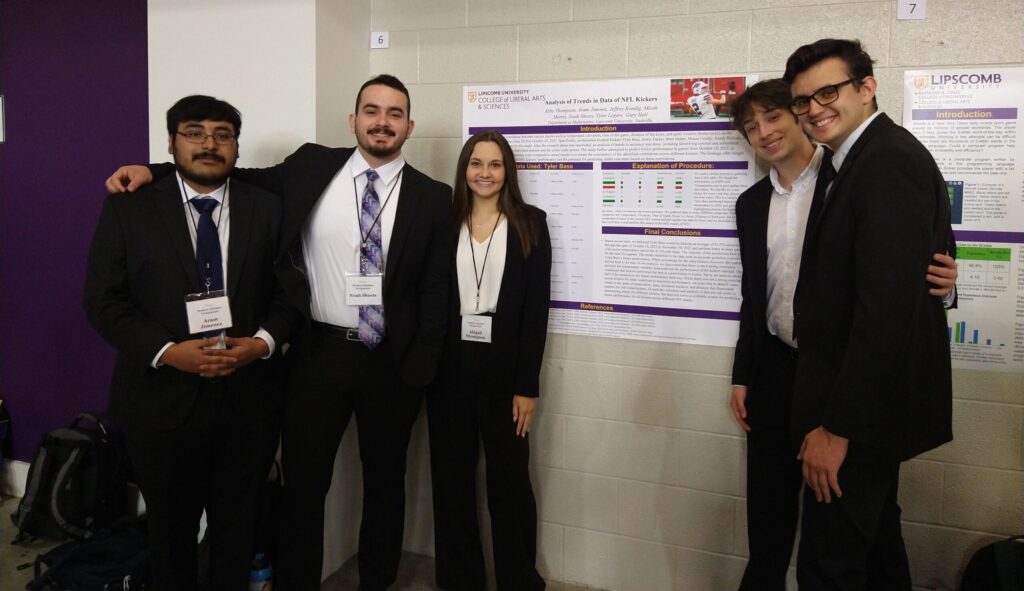
Kickin’ It – The data behind NFL kickers, how they make and how they miss
Not many positions in pro sports are as much as an anomaly as an NFL kicker. Kicking in the NFL isn’t just as simple as having a strong leg. It’s about accuracy and refinement. It’s about your other ten teammates stepping up and doing their job correctly; from the snap, to the hold, to the blocking, all the way to the kick itself. And even if some of those things go perfectly, a simple push of wind can turn a game-winning field goal that leaves you a hero, into a missed opportunity that sees millions calling for your job.
It’s a job that despite all of these factors, it’s comes down to a simple thing. Making kicks and missing kicks. However, what if I told you that it’s not that simple? That there’s actual data out there, compiled by students, that gives you a look at what impacts a kicker’s makes and misses?
At Lipscomb’s Student Scholar Symposium, six students; seniors Abby Thompson, Aram Jimenez, Micah Morris, Tyler Legere, Jeffrey Kendig, and junior Noah Sheets, presented their research on the data behind NFL kickers and what can impact their performances.
The group, who represented the Department of Mathematics, picked six different NFL kickers and analyzed the each kicker’s over the past four years. These kickers were selected to ensure that the study would get a wide variety of data from their games and were tracked throughout the season by a member of the group.
The kickers that they selected were Justin Tucker from the Baltimore Ravens, Randy Bullock from the Tennessee Titans, Brett Maher from the Dallas Cowboys, Tyler Bass from the Buffalo Bills, and Mason Crosby from the Green Bay Packers.
Distance, location (home or away), temperature, elevation and time of the day. They looked at each game that each kicker played, and also factored in whether or not the stadium these games were played in were indoor or outdoor venues (as well as if domes had an open or closed roof during the game).

The group used the data from the games that these kickers they played in, along with their previous season data to analyze how each kicker performed in each of these categories and broke them down into small percentages. They also predicted what they thought would happen in the future based on the analysis that they’d find.
How the group came up with the idea for the study isn’t your typical story. __ explained how his roommates’ interest in sports betting ended up snowballing into something bigger.
“We were joking around talking about competitors sports betting; cause we always lose. And then in class when we were discussing a topic, I was like, ‘oh, you know what’d be cool is if you could give yourself an edge on my roommate’s force betting.’ It started as a joke, but we ran with it, narrowed it down to, NFL kickers and said ‘wow, we could actually, you know, make an idea out of this that isn’t just sports betting.'”
One of the kickers that __ specifically mentioned was Tyler Bass of the Buffalo Bills. Bass, who Thompson followed throughout the project, provided the group with surprising results that they didn’t expect.
Despite Bass being used to kicking in cooler temperatures in Buffalo, something that the students thought would be an advantage for him, their research showed that Bass actually did better at away games; seeing better results in games with warmer temperatures and lower elevations.
“Collecting all that data really brought to light these trends that I honestly thought would’ve been completely opposite,” said Thompson, who tracked Bass’ games for the project. “Using that to be able to predict how he’s gonna do at certain stadiums based on the average temperature of that stadium at that day and over the past five years, was really interesting to see how all those different conditions really truly affect.”





